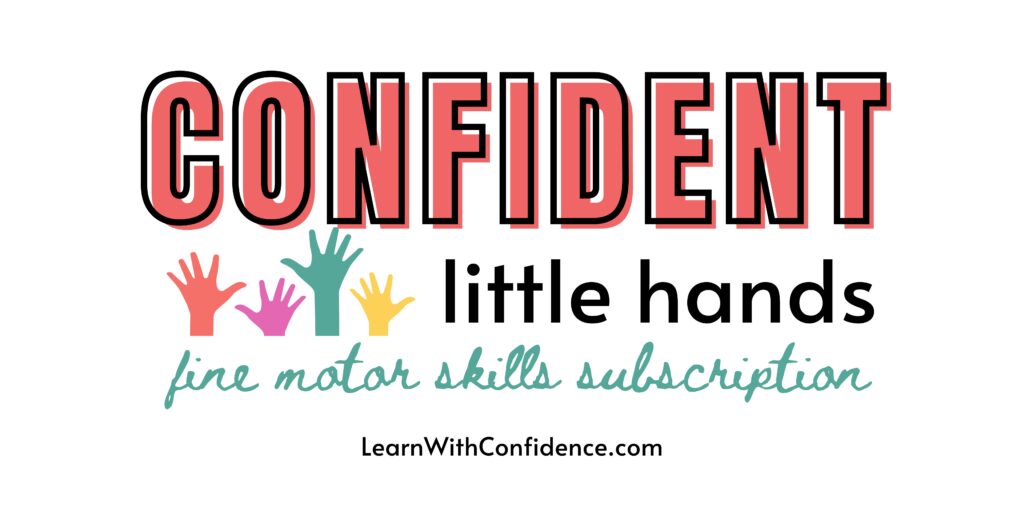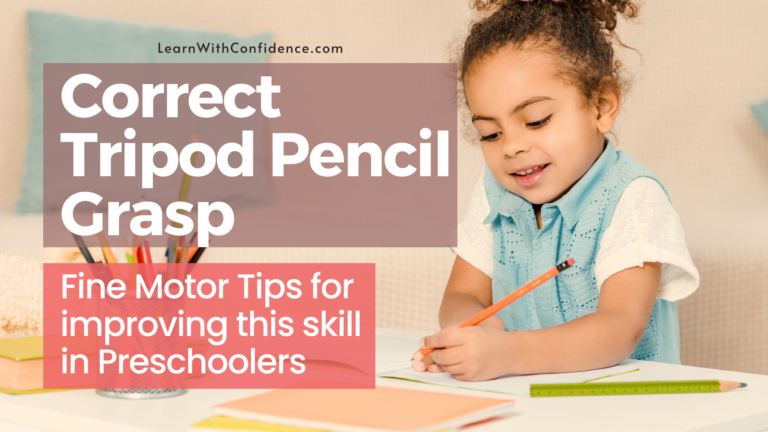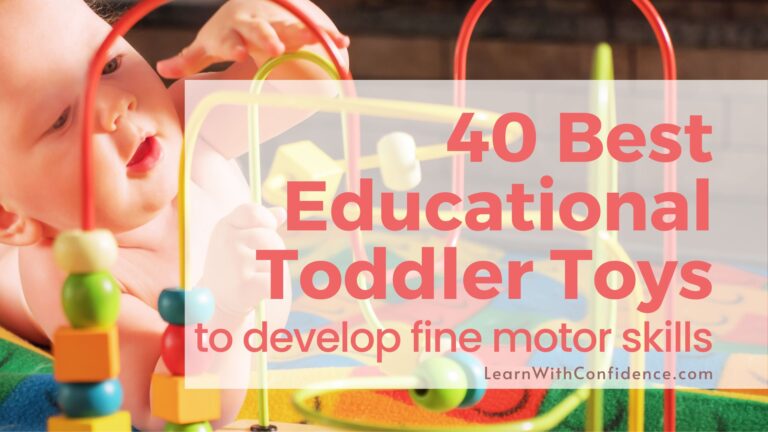Is your child reaching their Fine Motor Milestones? Here’s how you can find out.
Want to make sure your child is on track with their fine motor development? Every child is unique but these are some important milestones your baby, toddler or preschooler will be developing to ensure their healthy fine motor development.
How do you know if your child is on track with their fine motor development?
Fine motor skills are so important for a variety of reasons besides just being able to write or cut with scissors. But obviously, they are one of the most important developmental skills that can help your child succeed in school.
Making sure your child is developing the skills they need is a big priority. And you’re here today because this is obviously a priority for you too!
This checklist will give you a good idea of the kinds of tasks your child should be working on at each age and stage of their development. It will guide you as to the activities you can do with your child to make sure they’re developing within the norms of their age and stage.
Every child is unique and so is their fine motor development
Following a checklist like this one is super helpful but don’t forget that each child is unique and develops at their own pace. And just like when your kiddo was a tiny baby and didn’t necessarily walk for the first time on the day of their first birthday, it’s a process. And it takes time.
“Normal” has a really big range when it comes to child development.
So even though your toddler may be struggling with cutting with scissors, they may be thriving at pulling on their socks. And just because your preschooler finds it tough to color in the lines, it doesn’t mean they won’t.
There are lots of factors that have an impact on your child’s fine motor development. And each child’s experiences and genetics are different so while we can can discuss what the norms are for “average” development, it’s so important to keep some perspective.
Fine Motor skills for each age and stage
Fine Motor Skills for Babies (0-1 year olds)
In this age group, as your baby becomes more mobile you’ll see them using their whole body for lots of motions. Over time, they will refine these movements. But all of these gross movements are really important in setting up the body for fine motor development.
Here’s an example, being able to control their head, or being able to push themselves up when on their tummy, require things like core strength and shoulder stability. And these two gross motor skills are vital for good fine motor development later.
During this stage, your baby will start to use their hands to explore their world more and more. They will progress rom simply reaching out their hand toward an object to grasping it with their whole hand. By they time they’re 5 or 6 months, your little one will be able to hold a object confidently in one hand. And by the times they’re heading to their first birthday, they’ll be transferring objects between hands and even picking up tiny objects between their thumb and index finger.

Fine Motor Skills for Toddlers (1-3 year olds)
During this stage you’ll see a huge leap in your little one’s ability to do activities with their little hands. It’s such a fun stage!
Between 1 and 2 years, your little one will stage to be able to stack items like wooden blocks, they can color and paint but will be using their whole arm for the movement and they’ll hold the crayon with their whole hand.
Between 2 and 3 years, your toddler will start to refine some of those movements. They can now hold their crayon between their thumb and index finger but they’ll still be scribbling because they use their whole arm for the strength behind coloring. They can do wooden insert puzzles, threading big beads onto a shoelace and they’re even starting to develop their cutting skills by snipping things with scissors. This is the age we start to see hand dominance.

Fine Motor Skills for Preschoolers (3-6 year olds)
This age range is when you’ll see a drastic increase in the amount of tasks and complexity of tasks that your little one can accomplish. It’s a wonderful stage of growing independence and capability!
During that 3 – 4 year old age, your preschooler will be doing all sorts of things like dressing and feeding themselves more competently. They can start developing the correct pencil grip (tripod grasp) and while the strength is still mostly coming from the arm, you’ll start to see a bit more motion coming from the wrist.
Your 4 – 5 year old will start improving that tripod grasp and movement will be coming from the wrist. They can learn to write their name at this age and copy letters and numbers and shapes. and you’ll start to see improvement in all of the other fine motor activities your child is doing like how they page through a book or build their Legos.
By 5 -6 years old, you will marvel at all that your little one can actually do! Writing is improving with every bit of practice. Their tripod grasp is well established though you may need to remind them to hold their pencil correctly and you’ll see movement is coming more from their fingers than the wrist and arm. There are so many activities that they can do now from building puzzles to drawing and coloring, cutting and pasting.

Fine Motor Skills for Early Elementary / Foundation Phase (6-8 year olds)
By the end of the preschooler stage, your little one is well set up for success in Early Elementary or Foundation Phase (Grade 1-3) when many of these skills is being refined and writing becomes a priority.
During the stage when your child is 6 -7 years old, pencil control and endurance through writing tasks is improving. You’ll see your child is able to write on the lines better and draw detailed pictures. Their tripod grasp is being used well now and the movement is coming from their fingers and not the wrist any more.
By 7 – 8 years old, all those activities requiring fine motor strength and coordination are a lot easier for your child and they have the confidence to perform these tasks well. The focus now is on honing those skills and using them efficiently in a number of different circumstances. For example, you child can write well and get through the writing task, but they may need to work on maintaining that neatness through longer writing tasks.

What do I do to help my child in their stage?
Use the checklist to give you an idea of the tasks your child will most likely be developing at each stage. Then apply these three tips to your child and their fine motor development at that stage.
1) Build confidence and independence
We all know, a confident child, who believes they can actually achieve a goal and has proven to themselves that they can, is more likely to accomplish that goal. And they’re more likely to try new things that test their capabilities.
Developing skills is all about that – testing and trying new things and they honing those skills.
Build your little one’s confidence by highlighting their successes, however small. Encourage them with observations about their accomplishments and encourage them to feel proud of themselves and what they can do.
One of the most important ways to build confidence though is to encourage independence. Let them try things on their own and guide them gently rather than swoop in to correct and complete tasks for them.
(Obviously, there are times – like when you were supposed to have left 10 minutes ago and now your little one is insisting on tying their own shoe laces! “Swooping in” may be the solution in that scenario!)
2) Opportunities to explore variety of skills
The more our children experience, the more skills they are encouraged to explore and develop. Here’s an example: if your child has never threaded beads or macaroni, they may have a tough time lacing up their shoes one day.
Give your child lots of different opportunities to explore and develop their fine motor skills.
This doesn’t have to be difficult or complicated or expensive.
Here are some ideas to expand their experiences while developing their fine motor skills: Let them peg their socks onto a wash-line. Let them help tear up lettuce leaves for the salad. Give your child a variety of items to use to paint with like their fingers, a sponge, q-tips or paintbrushes. Practicing zipping up or buttoning different items.
Any task where they’re using their hands and developing strength and coordination in their hand and finger muscles is an opportunity for them to develop fine motor skills.
3) Is there progress?
Every child is different and develops in different ways at different times. The most important thing we should see in our children is progress and improvement as they get older and have more experiences with new things.
So when your child doesn’t quite meet a milestone or seems to be taking a really long time to master a skill, Mama, ask yourself “Is there progress?”
Are they getting lots of opportunities, in a variety of ways, to practice their skills? Is there an improvement from where they were at before? How much progress are they making?

Connect with me
Have you got a new way to play with your child while you have fun developing their fine motor skills – drop a comment to let us know!
Feel free to reach out in the comments or send me an email to connect. It’s my mission to equip and empower you to help your child succeed – you are, after all, the best person for that job, because you are the expert on your child.

I would love to connect with you and include you in this community of Mommies as we support each other and grow together to become the best moms we can be!
Get on my emailing list here and I’ll make sure I keep you in the loop on all the latest blog posts, freebies and resources!







